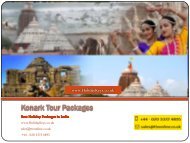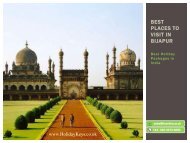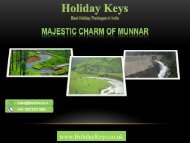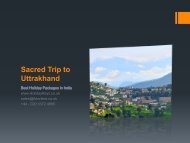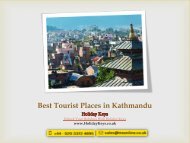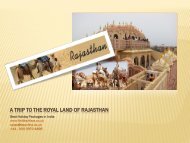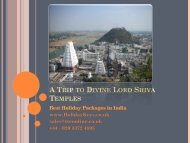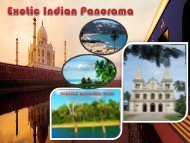Exclusive Heritages of India - HolidayKeys.co.uk
Places cover, Delhi, Gwalior, Dholpur, Agra, Fatehpur Sikri, Bharatpur, Jaipur. Day1: Arrival at Delhi airport.Overnight stay. Day 2: After having the breakfast, let’s begin your visit with UNESCO World Heritage Site Qutb Minar, which is at 120 meters and the tallest brick minaret in the world. It also includes an Iron Pillar which was constructed in the Gupta Empire, with the rust –resistant composition. And the Red Fort built by Shah Jahan the Mughal Emperor and Humayu’s tomb. All the architectures are standing with a grace and proud for years ago, with hand carved inscriptions and designs.
Places cover, Delhi, Gwalior, Dholpur, Agra, Fatehpur Sikri, Bharatpur, Jaipur. Day1: Arrival at Delhi airport.Overnight stay. Day 2: After having the breakfast, let’s begin your visit with UNESCO World Heritage Site Qutb Minar, which is at 120 meters and the tallest brick minaret in the world. It also includes an Iron Pillar which was constructed in the Gupta Empire, with the rust –resistant composition. And the Red Fort built by Shah Jahan the Mughal Emperor and Humayu’s tomb. All the architectures are standing with a grace and proud for years ago, with hand carved inscriptions and designs.
You also want an ePaper? Increase the reach of your titles
YUMPU automatically turns print PDFs into web optimized ePapers that Google loves.
<strong>Exclusive</strong><br />
<strong>Heritages</strong> <strong>of</strong><br />
<strong>India</strong><br />
www.<strong>HolidayKeys</strong>.<strong>co</strong>.<strong>uk</strong>
www.<strong>HolidayKeys</strong>.<strong>co</strong>.<strong>uk</strong><br />
<strong>Exclusive</strong> <strong>Heritages</strong> <strong>of</strong> <strong>India</strong><br />
Day1: Arrival at Delhi airport.<br />
Overnight stay.<br />
Day 2: After having the breakfast, let’s begin<br />
your visit with UNESCO World Heritage Site<br />
Qutb Minar, which is at 120 meters and the<br />
tallest brick minaret in the world. It also includes<br />
an Iron Pillar which was <strong>co</strong>nstructed in the<br />
Gupta Empire, with the rust –resistant<br />
<strong>co</strong>mposition. And the Red Fort built by Shah<br />
Jahan the Mughal Emperor and Humayu’s<br />
tomb. All the architectures are standing with a<br />
grace and proud for years ago, with hand<br />
carved inscriptions and designs.<br />
Afternoon: Sightseeing <strong>of</strong> Old Delhi takes you to the Raj Ghat (memorial to Mahatma Gandhi), Jama Masjid,<br />
– The largest mosque in <strong>India</strong>. Drive past Chandi Chowk, once an imperial avenue <strong>of</strong> Mughal Royalty which<br />
today is the busiest <strong>co</strong>mmercial area <strong>of</strong> the city. Overnight stay.
www.<strong>HolidayKeys</strong>.<strong>co</strong>.<strong>uk</strong><br />
<strong>Exclusive</strong> <strong>Heritages</strong> <strong>of</strong> <strong>India</strong><br />
Day 3: Morning board train for 5 hours.<br />
After taking a lunch and check in at a hotel and rest for about few<br />
minutes and proceed straight for sightseeing.<br />
As the name says that, it is a synonymous <strong>of</strong> its fort, and one <strong>of</strong><br />
the oldest <strong>India</strong>n forts. It has a famous and spectacular<br />
architecture architectures <strong>co</strong>nsisting in palaces and forts. The<br />
Tomar King, Man Singh (1486-1516) built the Man Mandir, a sixtowered<br />
palace de<strong>co</strong>rated with perforated screens, mosaics,<br />
floral designs and mouldings in Hindu plethora. Man Singh also<br />
built the Gurjari Mahal, a turreted palace <strong>of</strong> stone – now an<br />
archaeological museum. The Fort also <strong>co</strong>ntains a mosque and<br />
11th century temples.<br />
Overnight stay.
www.<strong>HolidayKeys</strong>.<strong>co</strong>.<strong>uk</strong><br />
<strong>Exclusive</strong> <strong>Heritages</strong> <strong>of</strong> <strong>India</strong><br />
Day 4: After the breakfast in the morning, your next<br />
visit to some other historical monuments such as the<br />
tomb <strong>of</strong> Muhammed Ghaus, a saint worshipped by<br />
the Mughals and the tomb <strong>of</strong> Tansen, Akbar’s famed<br />
<strong>co</strong>urt musician.<br />
After the enjoying the lunch and spend some time at<br />
leisure, let’s move towards Dholpur. Drive for 1 and<br />
half hours.<br />
Dholpur is named as Dhawalpuri after its ruler Dhawal Deo, once the ruler <strong>of</strong> the city, its name was distorted<br />
with the passage <strong>of</strong> time and got its present name Dholpur.<br />
The places <strong>of</strong> interest are Muchchhkund, which is about 8 kms from the town <strong>of</strong> the Dholpur and <strong>co</strong>mmands a<br />
picturesque view <strong>of</strong> the surroundings. The enclosures around it were supposed to have been built by Mughal<br />
emperor Akbar. Other place worth visiting is Laswari, it is here where Daulat Rao Scindia was defeated at<br />
hands <strong>of</strong> Lord Lake. Kanapu Mahal is another interesting building to visit. It is an old fort <strong>of</strong> historic importance,<br />
located toward the south <strong>of</strong> Dholpur tower. Also visit Shergarh Fort. This monument at Dholpur was built by<br />
Sher Shah Suri on the site <strong>of</strong> an earlier Hindu fortress. Overnight stay.
www.<strong>HolidayKeys</strong>.<strong>co</strong>.<strong>uk</strong><br />
<strong>Exclusive</strong> <strong>Heritages</strong> <strong>of</strong> <strong>India</strong><br />
Day 5: Early morning after breakfast drive to Agra for 1 hour.<br />
Let’s have something to eat and then proceed straight to sightseeing. Let’s begin with the symbol <strong>of</strong> love Taj<br />
Mahal, <strong>co</strong>nstructed by Shah Jahan for his beloved wife Mumtaz Mahal, one <strong>of</strong> the seven wonders <strong>of</strong> <strong>India</strong>.<br />
Next, Agra Fort, behind its forbidding red sandstone battlements lies palaces that tell the story <strong>of</strong> the Mughal<br />
Empire. The most impressive part <strong>of</strong> the Fort is the Dewan-e-Am, where the Emperor sat on his throne to<br />
dispense to his subjects, and the Dewan-e-Khas where he received foreign dignitaries. Visit the tomb <strong>of</strong><br />
Iltmad-ud-Daulah, father <strong>of</strong> Queen Nur Jahan – a two-storied tomb bearing mosaics in inlaid semi-precious<br />
stones.<br />
After a visit, you must be starving, then go for a lunch at a local restaurant.
www.<strong>HolidayKeys</strong>.<strong>co</strong>.<strong>uk</strong><br />
<strong>Exclusive</strong> <strong>Heritages</strong> <strong>of</strong> <strong>India</strong><br />
Proceed to Bahratpur for almost 1 hour to reach visiting Fatehpur Sikri enrooted. Fatehpur Sikri is 37 km,<br />
from Agra, is a ghost city built in the 16 th century by the Mughal Emperor Akbar. He met here the Saint Salim<br />
Chishti who predicted the birth <strong>of</strong> his three sons. It <strong>co</strong>nsisted <strong>of</strong> Persian style architecture Diwan – e – khas,<br />
Panch Mahal – a five storey building for the ladies and mistresses, a 54 meters largest gateway in the world<br />
– Buland Darwaza and a tomb <strong>of</strong> Salim Chishti.<br />
And later <strong>co</strong>ntinue drive to Bharatpur. Check in at a hotel and overnight stay.
www.<strong>HolidayKeys</strong>.<strong>co</strong>.<strong>uk</strong><br />
<strong>Exclusive</strong> <strong>Heritages</strong> <strong>of</strong> <strong>India</strong><br />
Day 6: After having a breakfast, let’s for Bharatpur’s 29 sq. km piece <strong>of</strong> marshland is one <strong>of</strong> the finest bird<br />
sanctuaries in the world, with over 360 species. It used to form the hunting estate <strong>of</strong> the Maharajas <strong>of</strong><br />
Bharatpur, and the daily shoot was reputed to be as high as 100,000 birds. However, Maharaja Brajendra Singh<br />
<strong>co</strong>nverted the estate into a bird sanctuary in 1956. Bird watching is good during winters when it is frequented by<br />
Northern hemisphere migratory birds. Among many other birds to be seen are egrets, ducks, <strong>co</strong>ots, storks,<br />
kingfishers, spoonbills, Sarus cranes and several birds <strong>of</strong> prey, including laggar fal<strong>co</strong>n, greater spotted eagle,<br />
marsh harrier and Pallas’ eagle. There are also chital deer, sambar, nilgai, feral cattle, wild cats, hyenas and<br />
wild boar whilst near Python Point, there are usually some very large rock pythons. After lunch drive to Jaipur<br />
for 3 hours. Check in a hotel and now it’s time for dinner and then stay overnight.
www.<strong>HolidayKeys</strong>.<strong>co</strong>.<strong>uk</strong><br />
<strong>Exclusive</strong> <strong>Heritages</strong> <strong>of</strong> <strong>India</strong><br />
Day 7: Morning excursion to Amber fort. Amber is a classic, romantic Rajasthani Fort Palace. The rugged,<br />
time-ravaged walls <strong>of</strong> the Fort may not look beautiful from the outside, but the interior is a virtual paradise.<br />
Miniatures painted on the walls depict hunting and war scenes, apart from festivals. Precious stones and<br />
mirrors are embedded into the plaster. Inside the Jag Mandir is the famed Sheesh Mahal – a room with all the<br />
four walls and ceiling <strong>co</strong>mpletely embedded with glittering mirror pieces, which were specially imported from<br />
Belgium during that period. En route to Amber Fort, you will have a brief photography stop at Hawa Mahal –<br />
the Palace <strong>of</strong> Winds.
www.<strong>HolidayKeys</strong>.<strong>co</strong>.<strong>uk</strong><br />
<strong>Exclusive</strong> <strong>Heritages</strong> <strong>of</strong> <strong>India</strong><br />
Afternoon sightseeing tour <strong>of</strong> Jaipur city visiting Maharaja’s City Palace, the former Royal residence, part <strong>of</strong> it<br />
<strong>co</strong>nverted into a museum. A small portion is still used by the Royal family <strong>of</strong> Jaipur. Built in the style <strong>of</strong> a<br />
fortified campus, the palace <strong>co</strong>vers almost one-seventh in area <strong>of</strong> the city. One <strong>of</strong> the major attractions in the<br />
museum is the portion known as Armoury Museum housing an impressive array <strong>of</strong> weaponry-pistols,<br />
blunderbusses, flintlocks, swords, rifles and daggers. The royal families <strong>of</strong> Jaipur once used most <strong>of</strong> these<br />
weapons. Later visit the Jantar Mantar, which is the largest stone and marble crafted observatory in the world.<br />
Situated near the gate <strong>of</strong> the city palace, the observatory has 17 large instruments, many <strong>of</strong> them still in<br />
working <strong>co</strong>ndition. Take a Rickshaw Ride in the local market to feel the pulse <strong>of</strong> Rajasthan. Overnight stay.<br />
End <strong>of</strong> services.<br />
You will experience the actual exclusive heritages <strong>of</strong> <strong>India</strong>, the tradition and treasures <strong>of</strong> <strong>India</strong>, what is <strong>India</strong><br />
in actually with its hidden gems.<br />
For details Call us: +44 – 020 3372 4895<br />
Email: Contact@Holidaykeys.<strong>co</strong>m




